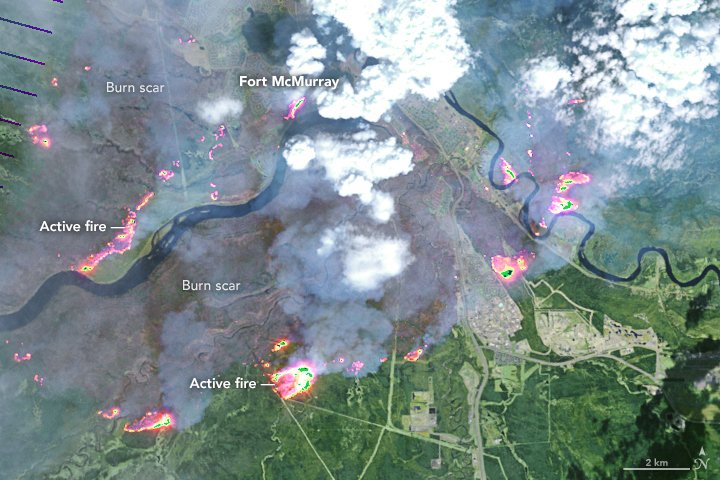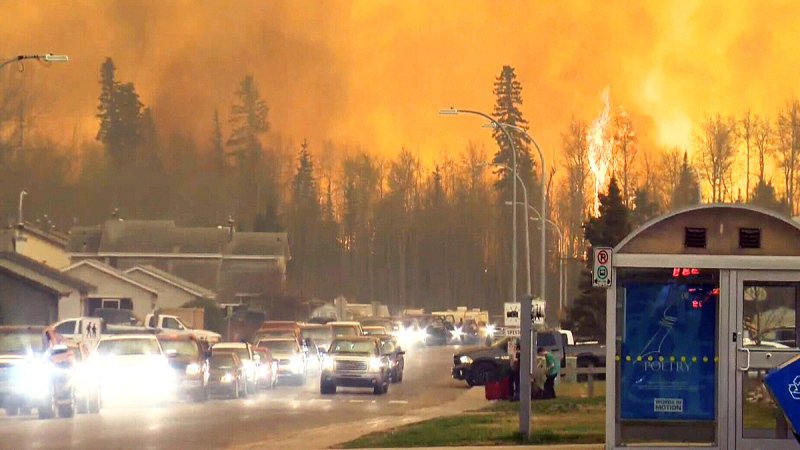Nature's Inferno Unleashed
We humans have a tendency to go where we should not, particularly. We love the challenge of living in unsustainable areas; floodplains, for example, and far too close to forests, making our lives and the infrastructure that has such meaning in our lives vulnerable to nature's idiosyncratic weather systems that can impact so disastrously on what we think, in our naivete, is permanence.
"Fire itself is always going to occur in these forest ecosystems. But we try and come up with solutions as far as mitigating the impact of those fires on communities."
"[FireSmart Canada's function is to help homeowners, industry and communities living at the intersection of the] wildland urban interface [cope, to protect themselves]."
"It keeps the fire [clearing out dead brush, pruning trees] on the ground, so there's a higher likelihood of success for firefighters on the ground of suppressing the fire."
"The first ten metres, we really focus on trying to significantly reduce the fuels, period. We really discourage the presence of conifer trees within the first ten metres and flammable vegetation, like junipers, within the first ten metres of homes, as well as sheds, wood piles, fences -- anything that can burn and help transition a fire towards the structure."
"Unfortunately ... with climate change and our forest health conditions, these fires are burning in conditions that we've never seen before. And they're burning hotter, bigger, faster and more aggressively than the fires that we've seen in the past and they're becoming a big challenge."
Kelly Johnston, executive director, Partners In Protection Association, FireSmart Canada
"It's important for people to understand that all the air tankers, all the suppression equipment, people, when conditions line up and that fire's ripping, it's going to do what it wants to do. You won't put it out, unless you do that work with the fuels."
Larry Fremont, wildfire education and prevention co-ordinator, Ministry of Environment, Saskatchewan
 |
| NASA Earth |
Alberta forestry authorities cleared out strips of forest around eleven northern communities last fall, removing what was seen as potential fuel to encourage forest fires. Wildfire prevention co-ordinator Larry Freemont cautions, that despite that preemptive work, he has himself seen fires jump breaks, including rivers or lakes. And now he can also include six-lane highways, because the situation seen now in Fort McMurray is quite exceptional. And science tells us these conditions are here to stay.
On their way, perhaps to becoming even more flagrantly lethal to people placing their trust in the skills and courage of firefighters and the equipment that has been developed in the past to fight fires that no longer reflect the types of fire situation now seen in northern Alberta and forecasted to increase in numbers, depth and capacity, given climate change and the ferocious alterations in climate moisture, winds and heat.
A report produced in the wake of a devastating blaze that took place in Kelowna, British Columbia in 2013, warned that past protocols no longer work and indeed add fuel to the fire. A buildup of trees, brush and other dry vegetation in forests -- everything that a fire depends on to help it grow and sustain its impact -- left lying on the forest floor because of past fire suppression protocols, has helped to produce the perfect firestorm. That biofuel that has been built up represents the potential for more severe wildfires and greater numbers, where people and the forest intersect.
And because people live, and work and spend their leisure time in and around those intersections of human habitation and natural surroundings of dense forests there is a certain vulnerability quotient that can be triggered. Where, though many forest fires are set by lightning strikes, many more result from human carelessness. And experts evaluating this fire that has consumed Fort McMurray tend to believe that something as mundane and yet as dangerous as a flicked cigarette butt, or a campfire not adequately put out, might have triggered this blaze.
This current wildfire raging through northern Alberta, destroying Fort McMurray and the hopes and dreams of the tens of thousands of Canadian living there fits the pattern of the dire new expectations. Tens of thousands of people using the only highway permitting entry and departure north and south from Fort McMurray have found themselves stranded. They've had to drive through dense, dark smoke so thick at times visibility was almost nil. They've seen, as they've driven, the fire up close and very personal. They've been stuck in stop-and-stall whenever the highway is closed for safety reason, as when fire jumps across and fears become even starker.
 |
| Sara Peats: Praying I have a home to go back to. Fire isn't over officials say the worst is yet to come. #FortMcMurrayStrong |
Some families have had to remain on the highway, stuck in a traffic line-up that will not begin again any time soon, for a day, for 36 hours, desperately awaiting the start-again. And Good Samaritans have set out from their comfortable and safe homes elsewhere in Alberta to truck in food, water, and gas in a convoy determined to do what they can to ensure that the residents of Fort McMurray who have lost everything they own but the clothes on their backs, their lives and those of their children -- and sometimes their pets, will know they're not forgotten. Some families fleeing the fire have taken shelter in communities north of their destroyed city, only to find the fire is tracking them there, too.
This fire, which looked serious on Monday, looked as though it might be under control by Tuesday, and then hot winds helped it grow tenfold from its Tuesday status, and mandatory notices went out to communities to flee. In one day it grew in size and ferocity 750 percent to encompass 850 square kilometres. People have taken the evacuation orders seriously. Although they will have lost everything they ever worked to own, none have yet lose their lives to the fire. Fort McMurray resembles a war zone, nature's own scorched-earth vendetta on humans who become too comfortable with themselves and their aspirations.
 |
| CTV News |
Labels: Alberta, Crisis Management, Environment, Humanitarian Crisis, Natural Disasters, Wildfire

<< Home